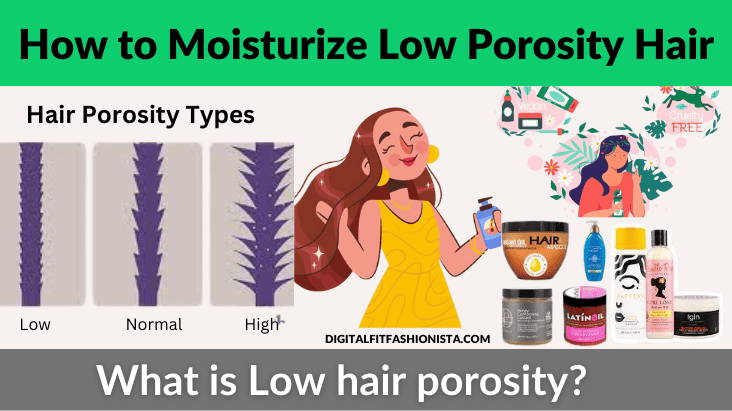Managing hair with low porosity can be difficult. It cannot absorb moisture, resulting in dry, brittle strands or even greasiness brought on by product buildup.
Do not be concerned if you are struggling with low-porosity hair. Learn How to Moisturize Low Porosity Hair. You may become an expert at moisturizing low-porosity hair with the appropriate method and a little hair science.
In this complete tutorial, we’ll go over what low porosity hair is, how to spot it, and most importantly, how to properly moisturize it to maintain healthy, beautiful locks.
What is Low hair porosity?
Let’s define Low hair porosity clearly before moving on to moisturizing techniques. Porosity is a term used to describe your hair’s capacity to absorb and hold moisture, and it is governed by how open the cuticle layer of your hair is.

Because the cuticles of hair with low porosity are closely knit, moisture has difficulty penetrating the hair shaft.
On the other hand, high-porosity hair has more open cuticles, making it easier for water to enter but harder to maintain.
Identifying low porosity of hair
Low porosity hair can be identified without a strong microscope. You can determine the porosity of your hair at home using a few indicators and quick tests:
Low porosity hair typically has a coarse or gritty texture to it.
- Split Ends: Hair with low porosity may frequently split ends.
- Lack of Elasticity: Hair with low porosity may not have enough elasticity, which makes it more likely to break.
- Product Buildup: Hair with low porosity may be prone to readily accumulating product residue.
- Slow Drying and Dullness: Hair with low porosity may be dull and take longer to dry completely.
How to Recognise Low-Porosity Hair
- Float Test
Try the float test to see whether you have low-porosity hair: drop some clean, dry hair strands into a glass of water; if they float near the top, you probably do.
- “Slip ‘n’ slide” test
Run a hair strand between your fingers and towards the scalp to perform the “slip ‘n’ slide” test; a smooth texture suggests minimal porosity.
- The Shower test
Another approach is to perform the shower test. If it takes a while for your hair to become thoroughly wet, you may have low porosity hair.
How to Moisturize Low Porosity Hair
To guarantee that moisture penetrates and is locked in, particular techniques must be used when moisturizing low-porosity hair. Here are some practical pointers to help you get the greatest outcomes:
- Apply oils or deep conditioners
- Emollients and Humectants
- Avoid using Heavy Oils
- Utilize Heat
- Apply Clarifying shampoo
- Weekly Deep Conditioning
- Protective Styles
- Cover your head overnight
- Use the greenhouse method
- Pillowcases and Satin Bonnets
- Water-Based style solutions
- Wide tooth Comb or Detangling Brush
- Apply oils or deep conditioners
Apply oils or deep conditioners to your hair before shampooing to retain moisture and prevent it from being stripped during the process. Use lubricants that penetrate, such as coconut, sunflower, olive, or avocado oil. After every use, properly rinse the area.

2. Emollients and Humectants
Look for hair products with emollients like jojoba oil, argan oil, and cetearyl alcohol, which create a protective barrier. Use humectants like aloe vera and glycerin, which draw in moisture. Your hair will retain moisture thanks to these substances.
3. Avoid using Heavy Oils
Avoid using heavy oils and butter; instead, use solutions that are liquid-based and easily absorbed by your hair. Heavy butter and oils could make your hair feel greasy.
3. Utilize Heat
Moisturizers can help lift the hair cuticle, facilitating improved product absorption. Applying them to the warm steam of the shower or with a hair steamer can do this. So utilize heat.
4. Apply Clarifying shampoo
Use clarifying shampoo on occasion to get rid of buildup and impurities that prevent moisture from accessing your hair shaft.
5. Weekly Deep Conditioning
To give your hair an extra moisture boost, incorporate a deep conditioning treatment. Which is rich in nutrients in your weekly hair care routine.
6. Protective Styles
To minimize manipulation and moisturize your hair, choose protective styles like braids, twists, or locs.
7. Cover your head overnight
To trap heat and promote moisture absorption, moisturize your hair and place a plastic bag over it overnight.
8. Use the greenhouse method
Use the greenhouse method by moisturizing your hair, wrapping it in a plastic bag, then inspecting it in the morning to see whether any droplets have accumulated.
Pay attention to symptoms like greasy hair after using moisturizers or persistent dampness after taking a shower since they could point to poor porosity hair.
9. Pillowcases and Satin Bonnets
To keep your hair moisturized and shield it from damage at night, use a satin bonnet or silk/satin pillowcase.
10. Water-Based style solutions
To keep your hair moisturized without generating buildup, choose water-based style solutions.
11. Wide tooth Comb or Detangling Brush
A wide-tooth comb or detangling brush should also be purchased to reduce hair breakage while detangling. To avoid undue harm to your hair, begin detangling from the tips and work your way up.
Conclusion: How to Moisturize Low-Porosity Hair
Here we came to the conclusion section of How to Moisturize Low Porosity Hair. Low-porosity hair could be more difficult to moisturize. But with the correct methods and supplies, you can give your mane the lush, moisturized appearance you want.
Always follow a consistent hair care regimen and adjust it as necessary to meet your hair’s specific needs.
Take pride in your hair’s natural beauty. With a little hair science on your side, you may achieve beautiful results and permanently banish dryness. Good luck moisturizing! Scroll down to read FAQs related to How to Moisturize Low Porosity Hair.
FAQs: How to Moisturize Low Porosity Hair
Is coconut oil good for low porosity hair?
Yes, coconut oil can be beneficial for low-porosity hair as its medium-chain fatty acids allow it to penetrate the compact cuticles, providing much-needed moisture and nourishment without causing heaviness or buildup. However, it’s essential to use it sparingly and consider other lightweight oils for better results.
What can I use for dry low porosity hair?
Use light leave-in conditioners with humectants like glycerin or aloe vera for dry, low porosity hair to efficiently hydrate and nurture the hair without leading to buildup. Regular deep conditioning treatments with substances like shea butter and coconut oil will also help maintain moisture and enhance the general health of your hair.
Should you moisturize low porosity hair?
Yes, moisturizing low-porosity hair is important since it aids in penetrating the dense cuticles, reduces dryness, and encourages healthy, nourished locks.
- Is it possible to reverse skin ageing? - August 21, 2025
- How to regain motivation during burnout? - August 12, 2025
- What is a digital detox day? - July 31, 2025


